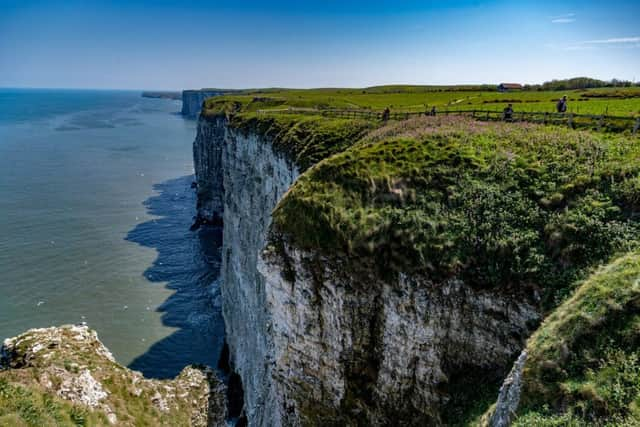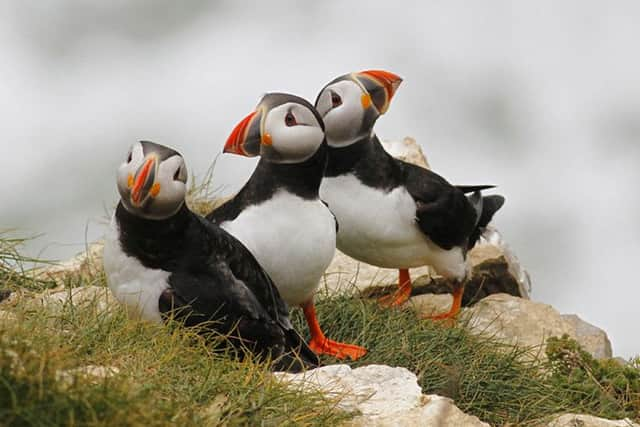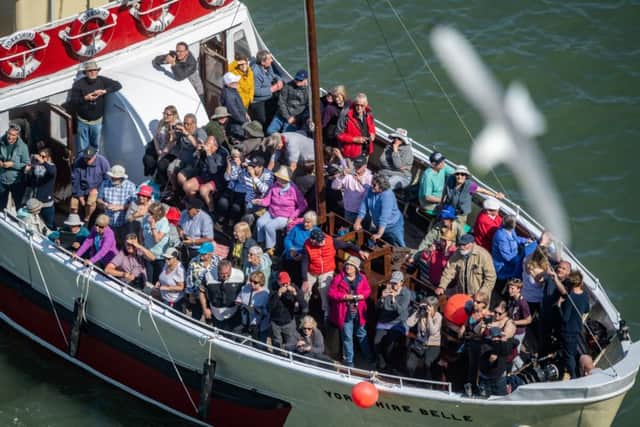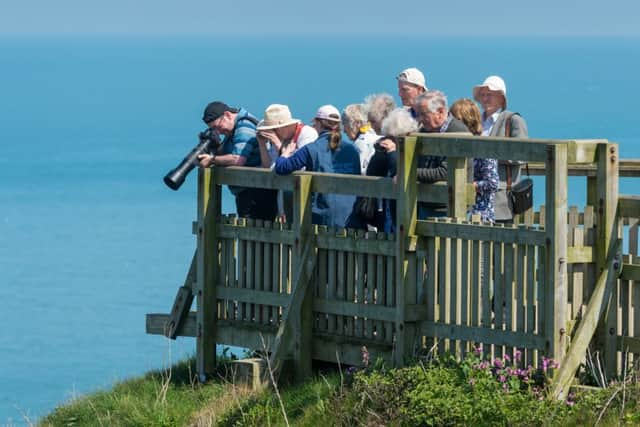Why the RSPB Bempton Cliffs seabird colony is Yorkshire’s greatest wildlife spectacle
The sight and sound of flocks whirling through the air and heading out to sea in search of food from Bempton Cliffs draws 100,000 visitors a year to its three-mile stretch of coastline between Flamborough Head and Filey.
They throng the clifftop viewing platforms to see the vast colonies of gannets – the largest in mainland Britain – guillemots, razorbills, fulmars and kittiwakes.
Advertisement
Hide AdAdvertisement
Hide AdAnd above all, they come to catch sight of the stars of this annual show during the breeding season from April to July – puffins, with their colourful bills, guttural cry and clockwork-toy flight.


Thousands of pairs of binoculars are trained on the ledges and crevasses in search of puffins, the visitors are given a helping hand by RSPB volunteers who train their high-powered spotting scopes on the birds.
This year marks the 50th anniversary of the RSPB establishing Bempton Cliffs as a unique nature reserve, gradually buying land from local authorities and private owners from 1969 until the early 1990s to create both a haven and a vantage point from which the seabirds can be studied and safeguarded.
Wildlife broadcaster Chris Packham called it the “Nou Camp of the bird world”, after Barcelona FC’s stadium with its dizzying height, and it lives up to that billing, the white cliffs of Yorkshire soaring hundreds of feet from the waves crashing at their base.
Advertisement
Hide AdAdvertisement
Hide AdBut despite being a fortress the sea can never breach, the cliffs are a fragile place, a barometer of the health of Britain’s seabird populations, and by extension the state of the marine environment they rely on.


And as Bempton hits its half-century, the reserve is at the forefront of informing and educating visitors about the threats to both, its sensitivity underlined by being at the heart of an area of special marine protection running from Flamborough Head to Filey, put in place by the Government in recognition of its importance to breeding seabirds.
David Aitken, 35, is the reserve warden. He has been at Bempton since 2011 after spending a year at another much-loved Yorkshire RSPB reserve, Fairburn Ings, between Leeds and Castleford.
“We can’t take what we have for granted. Seabirds are the fastest-declining species of bird. We have seabird colonies in Scotland that have crashed,” he says.
Advertisement
Hide AdAdvertisement
Hide Ad“Seabirds are the true indicator of the health of the sea. We cannot assume that this will be here in 50 years’ time, so we need to continue the protection, the lobbying, and inspiring people to make a difference.


“Seabirds have virtually no protection at sea, so we can protect the cliffs but they can’t breed if they’re starving to death, so we have to protect the marine environment. We’ve got 100,000 people here we can inspire and get that message to.”
The spectacular cliffs, with their six viewing platforms perched on the edge, give Bempton an advantage in getting the conservation message across.
“The cliffs pretty much do all the hard work for us, because the spectacle wows people,” says David.
Advertisement
Hide AdAdvertisement
Hide Ad“It’s a little bit different to other reserves in that it’s a tourist attraction as opposed to a traditional nature reserve.


“We get a lot of people who come here who have heard how fantastic it is and it’s easy to inspire them because the spectacle is second to none. There is nowhere like Bempton Cliffs in mainland Britain, in Europe, even the world.
“You can go to other sites in Europe and you never see the sights, or get the sounds and smells you do here. We need to make sure it stays as special as it is, and that takes a lot of effort.”
Visitor numbers to Bempton have increased dramatically in recent years, and so have school parties, with 1,500 children annually coming to the expanded visitor centre that opened in 2015.
Advertisement
Hide AdAdvertisement
Hide AdSocial media has boosted numbers, with a Facebook page and Twitter feed getting lots of hits from visitors who post pictures of what they have seen. Balancing more visits with conservation is a challenge, but the network of paths and the viewpoints mean the seabird colonies can be easily seen without being disturbed.
Visitors are increasingly learning about more than just the seabirds. As the reserve has developed over the past five decades, more emphasis has been laid on the wildlife back from the cliffs in the scrubland and nature trails.
Trevor Charlton, 62, is the former site manager, spending 20 years at Bempton between 1987 and 2007. He continues to volunteer, helping visitors get the most from the reserve.
He says: “In my day, it was all about the clifftop viewpoints and the seabirds, but now the habitat’s changed massively. There is the nature trail, and that’s absolutely superb for educating children, so you turn around from the cliffs and you’ve got all the birds, insects and amphibians.
Advertisement
Hide AdAdvertisement
Hide Ad“We had about 100 children here recently, and they were very inspired by this bug hotel, and they were saying ‘When I get home, I’m going to try to get my dad to make one’, and that’s a massive difference from my generation when we just had a nature table at school.
“We’re really lucky here to have a thriving population of tree sparrow and some people are just as excited to see their first tree sparrow as they are about seeing their first puffin.”
Bempton doesn’t just play a role in conserving wildlife on the cliffs and in the land back from them. The income from its visitors supports several other reserves, including on the Humber, and Coquet Island off the Northumberland coast.
If the cliffs enchant those who visit, they also cast their spell on David and Trevor, who share a favourite spot, close to the southernmost viewing platform at Staple Newk, where the view back up the coast towards Filey is magnificent.
“It would have to be something pretty special to take me away from here,” says David. “Probably seabirds, probably an island, because there is just nowhere else like this.”